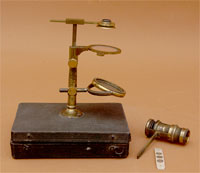 |
|||||
 |
 |
||||
 |
|||||
 |
 |
||||
Accessories include one bone sample slide included (butterfly specimens), one glass tube (probably a broken phial), and several mica sheets. Mica was used as coverslips for sample slides. Circular mica slips were stored in the included bone holder. The microscope is approximately 17cm tall.
Pierre (Peter) Dollond (1730-1820) was the son of John Dollond Sr (1706-1761) inventor of the achromatic doublet lens that solved the problem of chromatic aberration in telescopes and microscopes. John Dollond joined his son Peter in 1752 first to produce achromatic lenses and later to manufacture a wide range of mathematical, optical, and philosophical instruments including sundials, telescopes, barometers, and microscopes. Peter Dollond was admitted as a Brother to the Spectaclemakers' Company (1755) and went into business with his father c1752. Peter Dollond became Optician to His Majesty and to His Royal Highness the Duke of York in 1763. His nephew George (Higgins) Dollond joind him as partner 1804Ð1820, and succeeded Peter after 1820. Interestingly, Pierre's brother-in-law was the celebrated scientist and optician Jesse Ramsden. Ramsden made instruments for a number of London makers including Sisson, Adams, Nairne, and Pierre Dollond. In 1764 Dollond issued a pamphlet that described The Aquatic Microscope as improved by John Ellis, F.R.S. The microscope displayed here is a fine example of Dollond's Aquatic MIcroscope.
The Dollond family made a wide selection of optical instruments for some of the most influential people of the 18th century, including telescopes for Admiral Lord Nelson and Captain Cook.


